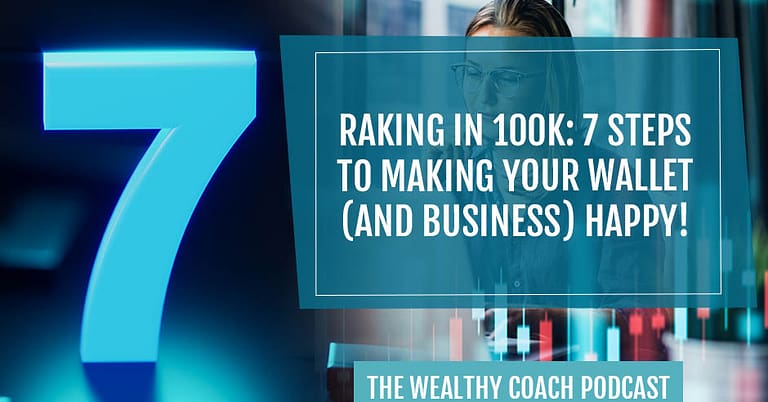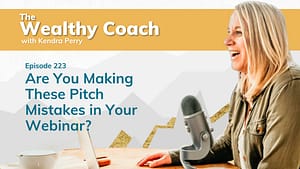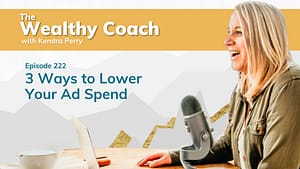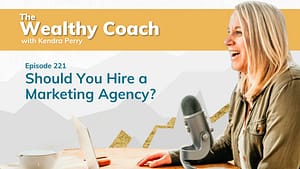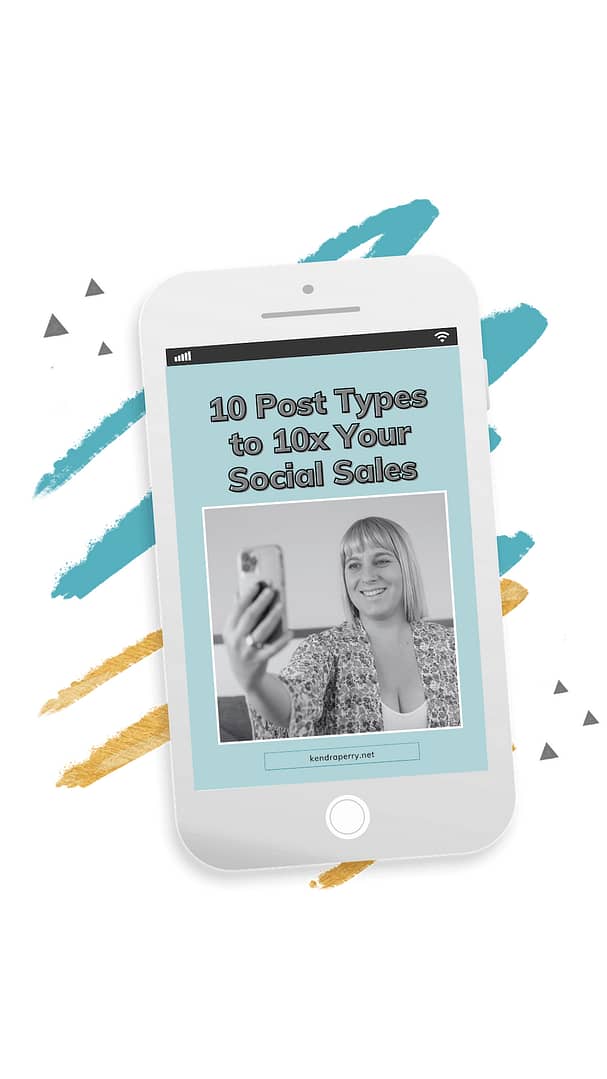Success in business and finances isn’t just about hard work; it’s about focusing on the right things. Join your host Kendra Perry as she discusses the seven key things that you need to focus on to rake in 100K and make your wallet and business happy. From managing your internal systems to having the right mindset, Kendra dives into practical tips and strategies that can help you grow your business and achieve financial success. Remember, the universe only gives you what you can handle. So if you can handle taking your business to the next level and raking in 100K, then this episode is a must-listen.
Nonviolent Communication Book: https://www.amazon.com/Nonviolent-Communication-Language-Life-Changing-Relationships/dp/189200528X
Practice Better: https://kendraperry.net/practicebetter
Best Platform for Finding Contractors: upwork.com
Want to work with me inside Health Coach Accelerator? Start with our free training video here: https://go.kendraperry.net/training
Give this podcast a 5-star review! https://ratethispodcast.com/wealthy
—
Listen to the podcast here
Raking In 100K: 7 Steps To Making Your Wallet (And Business) Happy!
In this episode, I want to talk about hitting $100,000 per year in your business. For a lot of us, this is our big goal. We hear about $100,000. Making $100,000 a year needs to be the goal. When we’re talking about $100,000 in revenue, not all of that is going to be taken home. That’s not going to be your profit. We have to strive to hit that $100,000 per year so that we can make at least $70,000 or $80,000 after profit. If you could do $100,000 a year in profit, that would be even better. Where a lot of people go wrong is they’re like, “I’d be happy with $70,000 or $80,000.” If that’s revenue, very quickly, you’re into the $40,000 or $50,000 profit per year, which isn’t enough to thrive.
The Mindset
I’m going to give you, in this episode, the seven things that I believe you need to think about in order to get to that $100,000 per year. The first one is the mindset. This is a very big part of running a business. There is a certain mindset that when people have it, I know they’re going to succeed. It comes down to the ability to take action and the ability to try things. Both of those are action-oriented. The truth is business comes from taking a lot of action. It comes from trying a lot of things. Finally, it comes from failing a lot. You need to fail more. The more you can fail, the more you’re going to progress.
This can be a bit of a head game for people because failing feels scary. With the way that we’re taught and we’re socially conditioned, we have this aversion to failure. We want to succeed. It’s rare that we consider all the failures that happen before someone gets to “success.” It’s my goal this 2023 to fail more. I want to try more things because every time I fail, I learn something. It gives me a data point. We have to think of failure as a data point. If you never do the thing, then you’ll never have a data point. If you do the thing, maybe you’ll succeed. That is also a data point. If you fail, that is still a data point.
Whether you succeeded or failed, what if they were neutral? What if they were the same? Both give you data points. With that data point, you can look at it if you’re willing to. You can fail and feel bad for a moment, but then, you can look at that data point and think, “Why didn’t that work? How could I improve that next time? Should I try something different?” It’s been my goal this 2023 to fail more. The more I fail, the more I learn and the more my business grows.
We have to make love with failure. We have to make love and get sexy with rejection. It’s important. When we think about business and sales, more people always say no than yes for the most part. There is a statistic out there that says between one and 5% of your total audience will become clients. That’s a small amount. That means that 99% to 95% of people will never become a client. They are going to say no. I want you to think about that.
Most people say no. Knowing that means that when we get rejected, it is a data point but also normal. It’s normal to get rejected. Even the top marketers, top business owners, and top health practitioners in the world are getting rejected more than they’re getting yeses. They may not always get that rejection outright if someone’s saying no to their face. Rejection can also be someone coming to their social media and thinking, “Not for me. I’m going to go with someone else.” We have to cultivate the proper mindset. This first thing is this whole concept of failure. It’s good to fail. Failure is a data point, so we need to try more things. We need to get intimate with rejection and be okay with it.
The other mindset piece that I want to mention here is the whole concept of self-belief. The reason why I was able to succeed in business is because of my self-belief. I’m not going to say that I felt it all the time. There were days when I didn’t believe in myself and I wanted to give up, and I thought, “I had made a mistake. This is normal.”
Overwhelmingly, I made the decision that I was going to make it work. I believed that I would figure it out. I didn’t know how long it would take me, but that’s the decision that I made. In the end, getting to that $100,000 mark in my business took me over three years. While I was in the thick of it or while I was in that three and a half years, I was dying a little inside every day. I was frustrated. I was suffering. I was struggling. I was confused. I was banging my head against the wall. When you think about that in the grand scheme of things, three and a half years to make $100,000 per year is nothing.
I came from working in forestry. They are seasonal jobs. I only worked 5 or 6 months out of the year, and then I’d have to collect unemployment or get some other job. If I was lucky, I was probably making $40,000 a year or maybe $50,000 a year. That’s what I was making. There was no hope in hell of me getting to $100,000 per year probably ever in the position that I was in. I might be able to get close to that, but I would need to work away so I could get an allowance or higher day rates because I was away living at a camp.
I could have worked in that job for 10 or 20 years, and I may have never gotten to $100,000 a year in a paycheck. Three and a half years and $100,000 a year in my business is nothing. I want you to think about that. Will it take you three and a half years? It could take you less. It could take you more. It depends. Everyone’s on their own journey. It could feel crappy when you’re in the thick of it.
The opportunity to make good money doing something that you love in a short amount of time is high if you stick with it. You need that self-belief. You need to believe that you can do it. That doesn’t mean that you feel that way every day all day because you won’t. That self-belief has to outweigh the doubt even if it’s by a little. It has to be enough to propel you forward. Building an online business is hard. You have to put yourself out there. You have to fail a lot. You have to try a lot of things. You have to have a lot of things not work. Not everyone can do that. It’s okay. Not everyone is meant for online business. That is what you’re going to be faced with.
If you want that, then this is the day to start learning how to deal with that. It’s okay to fail. It’s okay to have things not work. It doesn’t mean anything about you. It’s a data point. That is the first thing we need. I like to talk about mindset. This is why mindset is where we start in Health Coach Accelerator. It’s to make my students aware of the potential blocks that they are going to come up against as they work through their business.
A Clear Niche
For the second one, you might not be surprised because I talk about it all the time. It is the niche. The niche is very important. It’s one of the first big decisions that you will make in your business that will have a big effect on how successful your business ultimately is. The reason why we niche is to reduce our pool of competition.
Where people get tripped up is when they see these in-person practices or health practitioners who don’t have a niche but have a successful practice. Maybe you know of a naturopathic doctor. Maybe it’s your naturopathic doctor. They don’t have a niche. They are just a naturopathic doctor, but they’re busy with clients and probably generating six figures a year. That’s great, but it’s different when we think about the online space.
When you’re in person, you’re only trying to get the attention of people in your town or your city. You can rely on people walking by a storefront and seeing your business. That doesn’t happen online. The other thing when we’re talking about in-person is you’re not competing with that many other practitioners. Depending on the size of the place you live in, it might be a handful. It could be dozens or hundreds, but that’s about it.
When we move into the online world, we are not talking about a world where people are walking anywhere. We’re talking about billions of people on the internet who are never going to stumble upon your website. They’re not going to be walking online and then seeing your website. It’s not how that works. Because of that, when you don’t niche, you end up trying to get the attention of billions of people. It is exhausting because not only are you trying to get the attention of billions, but you’re also competing with hundreds of thousands of other health practitioners. It may be even a million. It’s a lot.

There are a lot of points of niching, but one of the big ones that I want you to think about is that it reduces the people who we’re competing with. It takes us from having to compete with maybe millions of practitioners and brings it down to maybe dozens or hundreds depending on the niche that we’re in. It also means that we’re not trying to get the attention of everyone. We’re carving out a little space in the marketplace. In this case, the marketplace is the internet. We’re only trying to get the attention of those types of people.
The other reason why niching is so important is because of the way that we’ve been socially conditioned with health and wellness. The great majority of us have been raised going to the doctor. When we have a symptom, we get a pill. When we have a problem, we see a specialized practitioner. If we have a gut problem, we see a gastroenterologist. If we have a brain problem, we see a neurologist. If we have a hormone problem, we see an endocrinologist. We’re very used to seeing the body as separate because that’s how we’ve been socially conditioned. That’s the paradigm that most people are living in.
When you became a health and wellness practitioner, coach, expert, or whatever, you didn’t accept all these concepts overnight. It was probably a process of learning something and being like, “That’s so different than what I’ve learned before.” You had to sit with it. You had to shed old beliefs, and then you learned a little bit more. My whole process of accepting and learning about natural health was a ten-year journey. I didn’t understand it overnight. Your people are probably not passionate about health and wellness. They don’t have the knowledge, education, or training that you do. They are still symptom-focused.
When we talk about marketing, you have to be clear about what problem you’re solving for people. That problem needs to be something that people have an awareness around. This concept of awareness, I want you to take this in. If people don’t think they have a problem, you’ll never be able to solve it for them because they’re not going to come to you. They don’t think they have that problem.
This is why niching is so important because people are out there googling on the internet and looking for specific solutions to specific problems. If they have an issue with acne, they’re not out there searching for how to improve their health. They’re looking for how to clear their skin or how to get rid of acne. They’re always going to choose a practitioner or coach to follow who specializes in acne because they’re going to feel like that person gets them. They’re going to feel like that person is speaking specifically to their pain points, their struggle, and how they’re experiencing the world with acne versus the person who is general and is talking about all the things and connecting with no one.
With niching, there’s often a lot of resistance. You’re like, “The body’s holistic. It’s not just about acne. It’s about gut, detox, and hormones.” I believe you. I know that to be true. When we’re talking about niching, it’s about marketing. It’s about communication. It doesn’t change how you work with people inside your program.

If you were going to sell a program that helped women in their 40s get rid of adult acne, you would still help them with hormones, detox, gut health, and all of the things. You would do that inside your program, but your communication would be focused on acne. Everything would be relevant to acne. You wouldn’t lead with how to heal your gut because people with acne are going to think, “My gut’s fine.” We know that you don’t have to have gut symptoms to have gut problems.
The niche is important. The clearer you can get with the niche, the better. I’ve watched several different practitioners at higher levels. I have a couple of friends who are in the multiple six-figure marks as health practitioners. They’ve been somewhat general over the past several years. Their business has come to a standstill. After me harping on them for a long time when I was like, “Niche,” and they were ignoring me, they finally did it. They saw a lot of traction in their business. Things started to take off.
It’s important even at higher levels, especially now because the internet is saturated. There are so many businesses coming online. Thanks, COVID, for ruining everything, but it opened up the online world to all the people who didn’t previously know it existed. There are going to be more businesses coming online in the next few years. This is why it’s important that we reduce our competition and client pool. It is so that we’re only focusing on a smaller group of people and we have less competition within that space.
Clear Messaging
The next thing I want to talk about, which is related to niching, number three is clear messaging. We talked about mindset and niche. We’re then talking about messaging. Messaging and niching are ultimately related. You can’t have one without the other. The niche is defining that statement like, “This is who I help. This is the problem, and this is the outcome I help them achieve.”
With messaging, you need to have the niche before you can message. Messaging is the communication that you put out there in everything. Everything needs to point back to the niche and the offer that you have that solves the problem for the person with that problem. We’re going to talk about offer in a second here. With messaging, everything needs to connect.
What I often see coaches and practitioners doing online is they define the niche. The niche can be quite good, clear, and specific, but their content is all over the place. Nothing connects back to it. People will follow them because they’ll be like, “This is me,” but then when they consume the content, they don’t understand what it has to do with the niche.
I have an example. This was a couple of years ago. I worked with a practitioner. She was clear that she helped women with bloating. When I went down to her Instagram feed, she was talking about bladder infections, parasites, and H. pylori. All those things are connected, but nothing was pointing back to the bloating and making that obvious connection.
Messaging is key. This is the biggest reason why people struggle at any level of business. This is why I struggle in my business, too. It is messaging. I’m always working on my messaging and dialing it deeper. It’s this continual thing. I’m in a program with seven-figure entrepreneurs. I see them struggle with messaging, too, and always needing to fine-tune it, make it better, and tweak it.

This is something that you’ll be continually working on. It’s something that you’ll develop over time. We want to think about the niche and everything we put out there in messaging, social media, email, or podcasts. However we create content on the internet, that needs to come back and point back to that niche or that person with the problem they have and the outcome that they want. That communication has to be clear.
For example, when people are interested in Health Coach Accelerator, I’ll give them a little biz audit to tell them if the program is right for them. If you want a biz audit, DM me on Instagram or Facebook the word biz audit and I’ll take a quick look at your social media and any links that you have. I’ll then tell you whether you’re hitting the nail on the head or whether you should probably come into Health Coach Accelerator and work with me to tidy up all the things that need to be tidied up.
One of the biggest issues I always see is messaging. I was auditing this woman’s page. She said she was a gut health coach, but I went to her program sales page and she was talking all about empowerment, energy, and vitality. I was like, “This doesn’t connect.” She had launched her program and has been unable to sell a single spot. She said she’d had tons of interest. I knew exactly why it hadn’t sold. It’s because she’s talking about gut health and saying she’s a gut health coach, but she barely mentioned gut health in the actual program.
Where people get confused is they are not noticing the distinction between the superficial problem and experience that people are having versus the root cause and method that they teach people inside the program. For example, if you’re talking about gut health, and gut health is something that you help people with, it needs to be all about the gut. When we’re talking about a sales page or your content, it all needs to be pointing back to the gut or that person. Messaging is important. Messaging is something that we’re always going to be working on in our business. That’s number three.
One High-Touch, One High-Ticket Program
Number four is one high-touch, one high-ticket program. People get miffed by this because a lot of times, we think we need more to make more money. We’re like, “We need a course. We need a group program. We need a one-on-one. We need this thing. We need that thing.” What that ultimately does is complicate your business.
For the most part, you are probably a solopreneur. Maybe you have a virtual assistant, but you probably don’t have a big team. When it’s just you, it’s always going to serve you better to have one main program. The more programs you have, the more you complicate and confuse your audience. When people are confused, they will not buy. It needs to be clear. Also, the more work you make for yourself. Each offer needs a different funnel and a different messaging. You need to be able to distinctively explain them. It should be clear what the difference between each program is. The more complicated you get in your business, the more you work and the more stuff you have to work on.
A big part of my journey over the past few years has been simplifying. I used to have all kinds of courses and offers. Ultimately, I couldn’t keep up. This is me saying this even with a team. Something always needed to be updated. Something always needed a sales page. We’re like, “This needs to be updated with this link.” It was so complicated, and I couldn’t do it anymore.
This is why I only have two main programs. I wish I could have one program, but I will not get rid of the two programs that I have. I have Health Coach Accelerator and HTMA Expert. They serve similar but a little bit different niches. The reason that I’m even able to have two programs is that HTMA Expert sells pretty passively. Whereas with Health Coach Accelerator, I have to put quite a bit of work into marketing. If I had to put an amount of work into both of them to market them both, then I’d probably have to make a decision that I wouldn’t want to make. I’d have to probably choose one.
I don’t know about you, but I’m not here on this planet to work all the time. I’m pretty happy working 25 hours a week. When I had multiple offers, I was working 40 or 50 hours a week. Remember that your program is always based on your niche. You don’t want to, like my example before, help people with digestive distress and have a program that’s all about energy. The connection’s not there. It’s not aligned. The messaging doesn’t make sense. People aren’t going to buy it. If you help people with digestive distress, then you have some kind of gut program that helps them solve their digestive distress.
Why do I say high-ticket? When I say high-ticket, it is anything over $1,500. People wonder, “Can’t I have a low-ticket or a lower-priced course or offer at some point?” You can, but I always recommend starting with the one high-ticket program because the hardest thing that you do in your business is sales. Sales is hard. Remember rejection. More people say no than say yes.
The lower you price, the more sales you need to make to hit your goals. When you need more sales, you need more traffic. Traffic is people. You need the bigger audience side. You need to run Facebook ads. You need more leads. That can be a lot, especially if you don’t have a big following. I know the majority of people who are reading this episode probably have Instagram followers or social media followers of probably less than 30,000. You’re probably not running ads. I know a lot of people who tune in to this show aren’t running ads. It makes it completely impossible to get to $100,000 when you are selling low-ticket. You need a big audience for that.
I’m not saying it’s not possible, and I’m not saying that it’s something that you can never do. Once you get the audience size and/or you are willing to invest in paid traffic, then you can go lower ticket. The fastest way for you to get to $100,000 per year is with the higher-ticket program or the program of at least $1,500. When you have one program and not multiple things, you can laser focus and narrow in on that program and make it the best. You can optimize the absolute living crap out of it and make it so good.
When you have an amazing offer that gets people the results and that delivers the transformation, it’s going to make your marketing a whole lot easier. That is because you’re going to have testimonials. You’re going to have social proof. Your clients are going to recommend you to their friends and family. They’re going to tell people about you. That is what builds a referral-based program. When you have one program, you can focus on making it the absolute best that it possibly can be. That’s number four.
Lead Generation
Number five is lead generation. These are the people whom we bring into our world who could become potential clients. Remember, most leads will never become clients, so you got to bring a lot in. When we talk about leads, I don’t see a social media follower as a lead. It’s hard to communicate with them based on how much engagement we typically get off social media. Know that it’s pretty average for you to get between 1% and 3% of your followers seeing your content. It’s quite low, so I don’t consider that a lead.
This is where we have this whole concept of the email list. We want to funnel people from social media in various places and get them onto our email list. That person on your email list is way more valuable because we can get email open rates as high as 20%, 30%, 40%, 50%, 60%, or even 70% or more. We have a greater ability to communicate with those people. People are way more likely to open an email that’s sitting in their inbox versus to be magically shown your post by the social media algorithm.
We need to leverage. To build an email list, you have to pull people from different places. As I see it, there are three main places that we can pull leads from. Number one is organic social media. When I say organic, I mean unpaid. You’re not paying for it. It’s you putting out a post on Instagram. We have organic social media. The way that I teach my students to use organic social media in Health Coach Accelerator is to focus on strategic types of posts that make people want to buy versus you being out there providing free content and impactful conversations.
I know it’s hard to grow on social media because the algorithm does tend to favor bigger accounts. If your only strategy is posting, then it can take a long time to get leads. You can engage with people who are liking your posts and comment on your posts. You can start conversations with them in Direct Message. Talk to them like a human. That’s going to be way more effective when combined with posting.
The second thing is something I call intentional collaborations. Collaboration means that you are collaborating with another coach or practitioner who has a similar or complementary niche. By doing that, you are gaining access to their audience that you would not otherwise have access to. An example would be a podcast interview. I could be a guest expert on somebody’s podcast and that would give me access to their audience. That can be cool.
When I say intentional, it needs to be intentional because you don’t want to be doing this with anyone. Let’s say you are a gut health coach and someone reached out to you. Maybe they have 100,000 followers, but they help men lose weight, and you help women with their gut. That would not be very intentional. You could get a lot of reach, but none of your audience is in their audience. You always want to ask yourself, “Is my audience in this person’s audience?”
Either the niche is the same or it’s complementary. What I mean by that is maybe you help women in their 40s balance their hormones. Maybe a yoga instructor wants to collaborate with you, and she focuses on helping women. All her clients or all her audience aren’t going to be necessarily women in their 40s with hormonal issues, but I guarantee your audience is probably in that audience. That would be a good collaboration.
Other examples of collaborations would be doing a workshop for another business. It could be a dual Instagram Live. It could be a Facebook Live that you do with someone. It could be guest blogging and that sort of thing. This is a good long-term strategy. When we’re talking about organic, which is unpaid, this is what you need to use. You need to use impactful conversations, social media posting, and collaborations. That is how you’re going to get out there and grow your business if you do not want to invest in paid advertising.
You can invest in paid advertising. This is something that I don’t cover inside Health Coach Accelerator. We focus on those organic methods. You can do something like Facebook ads, Instagram ads, YouTube ads, or TikTok ads. That stuff is available to you. You need to pay for it and need to know what you’re doing. I am someone who built my whole business to multiple six figures without paid ads. I started getting into ads in the past of couple years. To be honest, it’s something I’m still figuring out. I am running my own ads. My goal is to make Facebook ads my girl so that I can teach them to you guys.
Something that I love to do is I love to learn a skill. I hate to struggle with it, but in the end, I love it. I want to earn it so that I can teach it to my people. I would never teach anything that I haven’t mastered myself. If you’re someone who doesn’t want to do the organic stuff, let me tell you. You cannot get out of doing organic social media. Your organic social and your paid advertising have to work together.

If you have an ad out there, people are always going to check you out on social media. If you don’t have social media, people are going to think you’re fake. They’re going to think you’re a scammer. You do need to be posting on social media whether you do paid advertising or not. You can do paid advertising. It’s not necessarily a shortcut. It takes time to learn.
I would not do Facebook ads or Instagram ads without taking a course. You 100% want to take a course and learn how to do it. It’s technical. You can learn it. I learned it. It does take a little bit of time to learn. You have to be good at writing copy and creating graphics because it’s all about the creative, whether that’s a video or a carousel aesthetic post. It’s the same thing for social media. The messaging has to be on point. You can do paid advertising if you want to get more lead generation. Depending on how much you are willing to spend, you can get a decent amount of leads using paid advertising, but you have to know what you were doing. That is number five, and that is lead generation.
Sales Skills
Next is sales skills. This is important. You need to learn how to sell. The good news is selling doesn’t have to be like you think it is, which is this process of persuading, influencing, maybe feeling pushy, or trying to convince people. That never feels good. The way that I teach people how to sell inside Health Coach Accelerator is by serving. I believe that selling is serving.
In a sales conversation, if we’re talking about sales skills, for example, the majority of what you’re doing on a sales call is listening and learning. That’s it. You don’t want to be doing most of the talking. I believe good, healthy sales is a matter of holding space and asking powerful questions. That’s, in my opinion, all that sales is, but you will need to develop sales skills. There are a number of different ways that you can sell. You can sell straight off a sales page. You can sell off a sales call. You can sell off something like a webinar or something else. Those are all available to you.
When you’re starting out, I recommend that you have a sales page for your program that sends people on a call. The biggest mistake that coaches make early on in their business is they hear about this whole concept of a discovery call, and then they offer that call to anyone who will take it. What that ultimately leads to is having a lot of conversations with people who don’t give an absolute crap about your program and what you do. They’re looking for free information.

This is something that I experienced a lot early on in my business. I had so many people coming on calls who were looking for free coaching. What I learned is I needed to do some pre-qualification. The only place for them to get the link to the call was to read my sales page and go through it. That is because what the sales page told them was everything about my program. They learn that the sales call, the discovery call, or whatever you want to call it was only about learning more about my program. What that ultimately led to is me getting more qualified leads on the call.
Can you sell your program without a sales call? You can, but you need that messaging piece to be clear. You need messaging to be so on point. Otherwise, you are going to get people in your program who are the wrong fit. For example, with Health Coach Accelerator, my main way of selling is email and webinars. I don’t use a sales call. In a few years of having this program, I have not had anyone come to the program who is the wrong fit in terms of who they are and what their goals are.
There are people who’ve come into the program who haven’t executed it. They haven’t taken action. I have no control over that. Everyone who comes in is a health practitioner, personal development coach, or fitness coach and they are all in the right similar places in their business and have similar goals. How do I do that without a sales call? It’s my clear messaging. What people do is they get qualified through my webinar and email to the point where by the time they get to the order form, they’ve gone through all those filters. If they weren’t fit, they would’ve already dropped off.
You can sell directly through a sales page, but it’s not going to be a good place for you to start. The easiest way to sell right off the bat is through the sales page to the call. This is something we help coach accelerator students with. We help them write out their program sales page and teach them a very effective way to sell on a sales call that doesn’t feel like selling at all. It involves you barely talking. It’s amazing. It’s something that my HCA students will get when they come inside the program. If Health Coach Accelerator could be a fit for your business and you want me to take a look at what you’ve got going on, DM me the word biz audit on either Facebook or Instagram. I’ll take a look and tell you whether you’re a good fit for the program and if HCA can help you with your business.
Internal Systems
The final thing I want to talk about is internal systems. A lot of times, when we think about growing, we think about getting more clients, but you want to make sure your internal systems are dialed. You may not agree with me, but I’m really of the belief that the universe only gives you what you can handle. If I asked you the question, “Could your business take on ten clients tomorrow?” and you said, “No,” then you’re not going to get ten clients.
I believe we need to set up our internal systems and processes to be able to take on the clients that we want to take on. This involves automating. This involves organization. I’m a big fan of the client management platform Practice Better. It’s great. You can run group programs and courses out of it. It’s great for one-on-one as well. It organizes everyone into one place. You want to make sure that you are dialed on the inside.
This isn’t only about the organization and client management. It’s also about your customer service. You want to have good customer service so that when people interact with your business, they feel like they’re being taken care of. I’m sure you’ve interacted with a business, and maybe something didn’t go right. The communication was bad. You didn’t know what was going on. Maybe you didn’t feel heard. You felt disregarded. What that means is you’re never going to be a customer of that business again.
One of the main reasons why customers go to another competitor or decide not to work with you anymore is because they had a bad customer service experience. This is something that I teach my HCA students. What we focus all our customer service on is a book called Nonviolent Communication. Non-violent communication is a way of communicating that doesn’t put people on the defensive. It helps both parties be heard. It’s very disarming.
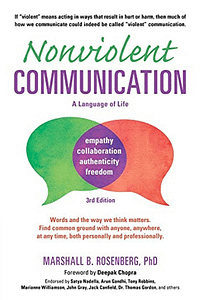
The guy who created the style of communication has utilized this process of communication to be the go-between between groups that have a lot of conflicts, like different competing gang members or Palestinians versus Israelis. It’s all kinds of different groups where typically, they wouldn’t see eye-to-eye and there’s been a lot of violence and that sort of thing. He’s utilized it to help them come to a clear understanding of each other. It’s powerful and something that we use in our customer service all of the time. That’s important.
There’s also outsourcing. Can you get to $100,000 without hiring a team? Yes, but I highly recommend getting a virtual assistant to help you with a few things in your business because you will be burnt out. You may get to $100,000 on your own, but you will be exhausted and burnt out. Outsourcing and team building, I put under this category of internal systems.
You don’t need a team, but find a virtual assistant who can help you answer emails, onboard your clients, help you with organization, help schedule out your social media, and maybe even make graphics for social media. There are people who you can find at any price point who can do this for you. My favorite platform for finding contractors is Upwork.com.
You want to make sure that the inside of your business is healthy. The worst thing that can happen is you get a client and they come into your business, and the experience of onboarding and getting onboarded into your business sucks. They have a bad taste in their mouths. It starts off the client-practitioner relationship badly. Maybe that person won’t recommend you. Maybe they won’t have good things to say about you.
The more we can optimize our internal systems and make sure that everyone who comes into our business is having a great experience, that things feel organized, that they know where things are, that they feel taken care of, and that they feel heard, the more likely they are to recommend us to someone else, which is big.
To summarize, these are the seven things that you are going to need in place to get to that $100,000 per year goal. Number one is the mindset. Remember, we want to fail more. We want to try more things. We want to have a healthy relationship with rejection. Number two, we want that clear niche so that we don’t have to compete with as many practitioners. We’re not trying to get the attention of billions. We want clear messaging so that everything connects back to our niche and our program.
That brings us to number four, which is that one high-touch, high-ticket program so that our focus goes all into one program that we can make the absolute best. If we want to add more offers, even lower-ticket offers in the future, we can do that once we have the traffic and possibly the money for ads. Number five is lead generation. When we’re talking about lead generation, remember, we’re talking about pulling people onto an email list so that we have the opportunity to communicate with them and build a relationship with them.
When we’re talking about organic, we’re talking about social media, impactful conversations, and those intentional collaborations. Also, you can do paid advertising. That is also available to you. Number six is sales skills. It is learning how to sell, which is holding space and listening. I recommend that people do that with a sales page, a sales call, and then finally, your internal systems where we were talking about program optimization, customer service, and hiring a virtual assistant.
Did you love this episode? I hope you did. If you want to support the show, I would love it if you could leave me a five-star review on iTunes. You can go to RateThisPodcast.com/Wealthy. If that’s too much work for you, and I get it because we’re all busy, simply make sure you’re subscribed to the show. Hit the subscribe button and download the last three episodes. That will take you five seconds, and it helps me out. I would so appreciate that. I will see you next time at the same place and the same time where I help you become wealthy AF.
Important Links
- Instagram – Kendra Perry Inc
- Facebook – Kendra Perry Inc
- Practice Better
- Nonviolent Communication
- Upwork.com
- RateThisPodcast.com/Wealthy
- https://Go.KendraPerry.net/training

